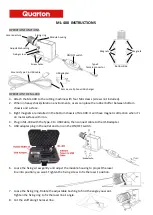
Setup/hold triggering uses the setup/hold violation zone to detect when data is unstable too near the time it is clocked. Each time
trigger holdoff ends, the instrument monitors the data and clock sources. When a clock edge occurs, the instrument checks the
data stream it is processing (from the data source) for transitions occurring within the setup/hold violation zone. If any occur, the
instrument triggers with the trigger point located at the clock edge.
The setup/hold violation zone spans the clocking edge as shown above. The instrument detects and triggers on data that does
not become stable long enough before the clock (setup time violation) or that does not stay stable long enough after the clock
(hold time violation).
Rise/Fall time trigger concepts
Rise/Fall time triggering is based on the slope (change in voltage/change in time) of a pulse edge.
Use the Rise/Fall trigger to trigger the instrument on pulse edges that traverse between two thresholds at faster or slower rates
than the specified time. You can set up the instrument to trigger on positive or negative edges. The trigger can be logic qualified.
Sequential (A B) trigger concepts
In applications that involve two or more signals, you may be able to use sequential triggering to capture more complex events.
Sequential triggering uses the A (Main) trigger to arm the trigger system, and then uses the B (Delayed) trigger to trigger the
instrument if a specific condition is met.
You can choose one of two trigger conditions:
■
Trigger after a Delay. After the A trigger arms the trigger system, the instrument triggers on the next B-trigger event that
occurs after the trigger delay time. You can set the trigger delay time with the keypad or a multipurpose knob.
■
Trigger on the Nth event. After the A trigger arms the trigger system, the instrument triggers on the Nth B event. You can set
the number of B events with the keypad or a multipurpose knob.
NOTE. The traditional delayed trigger mode called "Runs After" is controlled by the Horizontal Delay feature. You can use
horizontal delay to delay acquisition from any trigger event, whether from the A trigger alone or from a sequential trigger that
uses both the A and B triggers.
Visual Trigger concepts
Visual Trigger makes the identification of the desired waveform events quick and easy by scanning through all acquired analog
waveforms and graphically comparing them to geometric shapes on the display. By discarding acquired waveforms that do not
meet the graphical definition, Visual Triggering extends the oscilloscope’s trigger capabilities beyond the traditional hardware
trigger system.
Although Visual Trigger is similar in appearance to mask testing, where acquired waveforms are graphically compared to mask
regions on the display, there is an important difference. Visual Trigger only displays waveforms that conform to the specified
shape, so only conforming waveforms are measured.
Creating a visual trigger always begins with setting up the oscilloscope’s hardware trigger system to acquire the waveforms in a
standard trigger mode. The trigger can be as simple as an edge trigger or as complex as a pulse width, runt, logic multi-state
trigger.
Once a standard trigger is set up, create visual trigger areas to refine the trigger condition. Each visual trigger areas is associated
with a specific analog input channel, and you can define areas for multiple channels. See
on
page 121. By default, newly-created areas are rectangular, are associated with the selected channel, and are assigned the logic
condition In when created.
Once areas are created on the oscilloscope's display, they can be re-positioned, re-sized, and/or edited interactively on the
screen to create the required shape to define the visual trigger condition. See
Edit visual trigger areas using the Area menu
page 125.
Trigger concepts
MSO54, MSO56, MSO58, MSO58LP, MSO64 Help
425
Summary of Contents for 6 series
Page 24: ...Product documents and support 4 MSO54 MSO56 MSO58 MSO58LP MSO64 Help ...
Page 42: ...Options 22 MSO54 MSO56 MSO58 MSO58LP MSO64 Help ...
Page 54: ...Install your instrument 34 MSO54 MSO56 MSO58 MSO58LP MSO64 Help ...
Page 84: ...Getting acquainted with your instrument 64 MSO54 MSO56 MSO58 MSO58LP MSO64 Help ...
Page 102: ...Configure the instrument 82 MSO54 MSO56 MSO58 MSO58LP MSO64 Help ...
Page 148: ...Advanced triggering 128 MSO54 MSO56 MSO58 MSO58LP MSO64 Help ...
Page 154: ...Zooming on waveforms 134 MSO54 MSO56 MSO58 MSO58LP MSO64 Help ...
Page 438: ...Waveform acquisition concepts 418 MSO54 MSO56 MSO58 MSO58LP MSO64 Help ...
Page 448: ...Waveform display concepts 428 MSO54 MSO56 MSO58 MSO58LP MSO64 Help ...
Page 518: ...Index 498 MSO54 MSO56 MSO58 MSO58LP MSO64 Help ...
















































